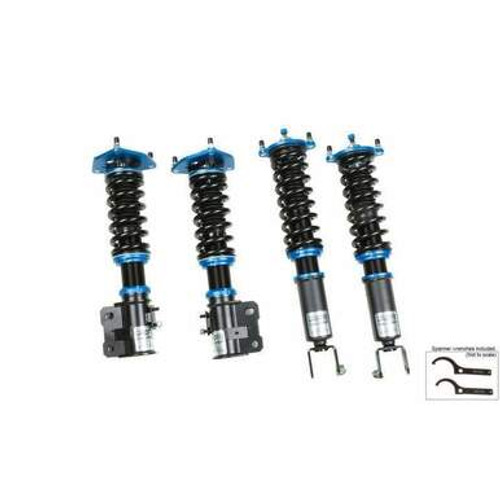Product Description
Specifications:
Part Number: 610701
OD: 6-1/8"
Bore Diameter: 1.7328"
Length: 1.779"
Weight: 6.8 pounds
Rotating Weight: 4.5 pounds
Engine Type: Internal
Finish: Black Zinc Chromate
Description:
The Fluidampr Harmonic Balancer Crank Pulley replaces your crank pulley to control the harmonics through all RPM ranges of your engine. The precision machined and balanced internal inertia ring inside the precision machined and balanced housing is constantly shearing through the silicone tuning to the harmonic frequency bandwidths that your engine is producing real time.
Rubber (elastomeric) dampers are only tuned for a specific narrow bandwidth of harmonics and they cannot tune up or down to what your engine is producing. They also wear out and have to be rebuilt or re-tuned frequently. The Fluidampr products never wear out or have to be re-tuned, as they are constantly balancing the engine to max efficiency via the internal inertia ring. Fluidampr also helps to calm down the chatter associated with double disc clutches.
Decreased engine vibration. No more flywheels, crank trigger wheels, or timing gears falling off of the crankshaft. This was unavoidable when revving past 8000rpm in the past.
- Decreased "Clutch/Gear Box Chatter" which is caused by lightweight single mass flywheels.
- Reduction in rpm drops when shifting in a competitive environment.
- Gains of 3-10whp and 5-13ft/lbs. of torque depending on your current setup.
- An overall more efficient and reliable engine.
What is a Harmonic Balancer, aka Crankshaft Damper?
A harmonic balancer reduces destructive crankshaft torsional vibration, which is the end-to-end twisting/rebound motion, that is naturally generated during each power stroke. A harmonic balancer contributes to greater valve train and timing efficiency, plus reduces wear of critical engine components such as main bearings, oil pump and the crankshaft itself.
A harmonic balancer often incorporates the main drive pulley and by appearance is often overlooked as having no essential function to the life of the engine. If the drive pulley is incorporated with the harmonic balancer, removing or changing it to a lightweight design, or using a low quality product MAY BE THE SINGLE BIGGEST COSTLY MISTAKE YOU CAN DO TO YOUR ENGINE.
Why Do I Need a Performance Harmonic Balancer, aka Crankshaft Damper?
Performance parts that increase torque, such as intake, exhaust, cams, and ECM changes typically cause an increase in torsional vibration magnitude, but keep frequency the same. Evidence that your stock harmonic balancer is not performing adequately will be cracked, bulging or missing rubber between the hub and outer ring. This is caused by excessive heat retention, over stretching and age. A common failure will be the outer ring separating from the hub causing damage inside the engine bay. Most race sanctioning bodies require a SFI 18.1 spec damper as a safety caution.
Performance parts related to the rotating assembly, such as rods, pistons, crank, flywheel/flexplate usually changes both torsional vibration magnitude and frequency. A stock harmonic balancer typically is only tuned for a 50hz peak variance. Move beyond its parameters and it may leave your critical engine components unprotected when torsional vibration is at its peak.
Due to the countless combinations of performance upgrades the simplest and more effective solution is to install a Fluidampr performance damper. By design, Fluidampr protects across a broad frequency and can become more effective as magnitude increases. The earlier a Fluidamper performance damper is installed, the more you’ll benefit from the protection, performance and durability in the long run.
How Does a Fluidampr Damper Work?
Unlike a stock elastomer harmonic balancer, Fluidampr performance dampers protect across a broad frequency range and can become more effective as magnitude increases throughout your RPM range. Each Fluidampr performance damper is designed for the engine application it is intended for.
Fluidampr performance dampers consist of a free rotating inertia ring inside a laser sealed outer housing within tight tolerance of each other. Both the inertia ring and the outer housing are computer balanced to exceed OEM specifications during manufacturing. Between the two, an area referred to as the shear gap is pressure injected with viscous silicone. This specialized silicone maintains stability across an extreme temperature range and provides superior heat dissipation.
As soon as your engine fires torsional vibration is present. To damp its destructive effects, the outer housing turns at engine RPM, while the inner inertia ring immediately self-centers and is free to be ‘shocked’ by each torsional vibration event. As the inner inertia ring moves in-and-out of RPM with the outer housing, the shearing force through the silicone transforms the vibration to heat, which rapidly dissipates through the housing. Since the mass of the inertia ring is engulfed in a thin film of silicone and not directly connected to the crank, it can be calculated that only 2/3 of the total Fluidampr weight is rotating at RPM. For example, a 7.9lb Fluidampr for a Chevy LS1 only feels 5.3lbs at rpm.
The Fluidampr design originated from top race engine builders requesting Vibratech TVD (formally Houdialle and parent company to Fluidampr) to bring its viscous damper technology engineered for long-life, high power diesel applications to professional motorsports in the early-1980s to replace failing elastomer designs. Viscous torsional dampers are used today as original equipment on select luxury sportscars, light-duty diesel trucks and even military spec engines. Meanwhile, nearly all high power engines that move our economy depend on a viscous damper for superior protection, performance and durability.

















